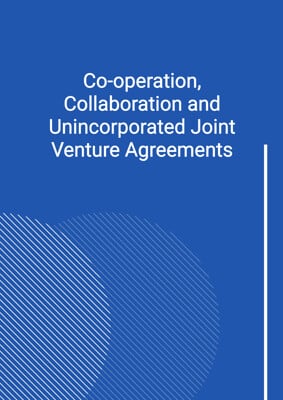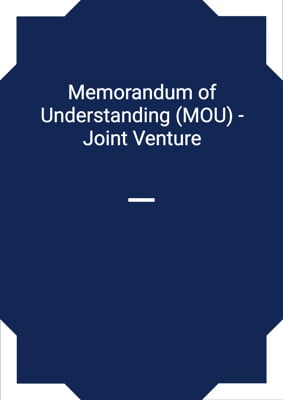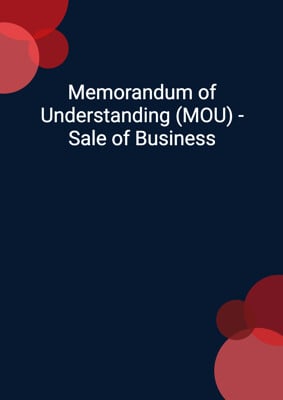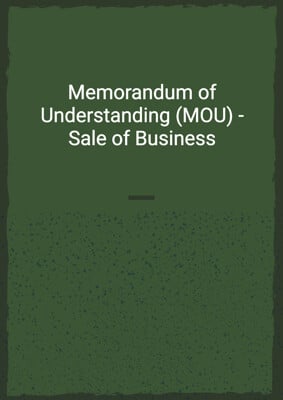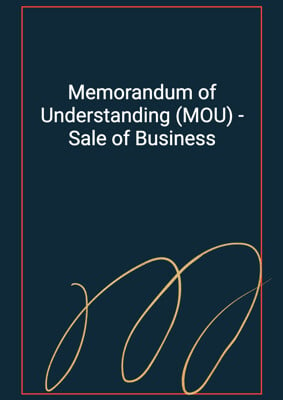
Memorandum of Understanding (MOU) - Joint Venture
Other Participant
A memorandum of understanding (MOU) in a joint venture situation. This represents the good faith intentions of the parties to proceed but is not legally binding. This document is drafted in favour of joint venture participants other than the leader.
How to Tailor the Document for Your Need?
01
Create Document
Fill in the details of the parties. You can click the "Fill with Member’s Information" button to complete it with information saved to your account.
02
Fill Information
Please fill in any additional information by following the step-by-step guide on the left hand side of the preview document and click the "Next" button.
03
Get Document
When you are done, click the "Get Document" button and you can download the document in Word or PDF format.
04
Review Document
Please get all parties to review the document carefully and make any final modifications to ensure that the details are correct before signing the document.
Document Preview
Document Description
A Memorandum of Understanding for a joint venture is a preliminary agreement that outlines the key terms under which two or more parties intend to form a joint venture company or partnership. While this MOU is not legally binding for most of the provisions, it serves as a basis for further negotiations, due diligence and ultimately drafting a formal agreement by establishing a common intention.
When parties are exploring the possibility of forming a joint venture, they often need to exchange sensitive business information such as trade secrets, financial data, customer lists and other proprietary information. Yet, sharing such confidential information carries risks, as it could potentially be misused or disclosed to third parties, causing harm to the companies involved. This MOU for a joint venture includes a confidentiality clause that legally binds the parties to keep the shared information confidential.
Although an MOU is not legally required but is highly recommended, especially for more complex joint ventures involving multiple parties, large investments, intellectual property contribution and international aspects.
The document is divided into several sections, each providing a detailed introduction and description of the key aspects of the joint venture. The first section focuses on the establishment of a joint venture company, including the preferred intention to create a new jointly-owned company and the proposed name of the joint venture.
The second section outlines the activities of the joint venture, specifying the purpose and scope of the business. It also mentions the development of an initial business plan and the regular review and updates of the plan by the joint venture company's board.
The third section addresses the technology aspect of the joint venture, highlighting the parties' commitment to making their existing technology available to the joint venture. It mentions the need for detailed arrangements regarding technology transfer, improvements, controls, and licensing.
The fourth section discusses the valuation of the joint venture, including the negotiation of an appropriate valuation process and methodology. It also mentions the provision of information by each party for the valuation process and the resolution of any material differences in valuations.
The fifth section focuses on the capital and funding of the joint venture, stating the intention for the joint venture to be self-financing and obtain additional funds from third parties. It mentions the parties' support for the joint venture's business plan and the provision of guarantees and undertakings.
The sixth section addresses the board and management of the joint venture, including the equal appointment of directors by each party and the rotation of the chairman position. It also mentions the initial appointments and subsequent appointments of senior management.
The seventh section discusses the shareholders agreement, highlighting the reserved key decisions for mutual agreement, such as changes in the scope of the business, major contracts, and appointments/removals of senior management. It also mentions provisions on dividend policy, auditors, financial year, and pre-emption rights.
The eighth section addresses the requirement for third-party approvals, including consents from other partners and relevant regulatory authorities. It emphasizes the parties' cooperation in obtaining these approvals.
The ninth section focuses on confidentiality and announcements, stating the parties' obligations to keep information confidential and obtain prior approval for public announcements or press releases.
The tenth section briefly mentions dispute resolution and the jurisdiction clause.
The eleventh section provides details on notices and service, including the methods of serving notices and the addresses of the parties.
The twelfth section clarifies that the document does not confer any rights to third parties.
The thirteenth section states that the MOU is not legally binding, except for certain clauses regarding confidentiality, dispute resolution, notices, and no rights of third parties.
The document concludes with the signatures of the authorized representatives of both parties.
How to use this document?
1. Review the entire document to understand the principles and proposed joint venture between the parties.
2. Pay attention to the detailed introduction and description of each section, including the establishment of the joint venture company, the activities of the joint venture, the technology aspect, the valuation process, the capital and funding, the board and management, the shareholders agreement, third-party approvals, confidentiality and announcements, dispute resolution, notices and service, and legal obligations.
3. Consider the implications of each section in real practice, such as the need for careful review and agreement on detailed terms, the establishment of a new jointly-owned company, the contribution of existing technology, the negotiation of valuation process and methodology, the self-financing nature of the joint venture, the appointment of directors and senior management, the reserved key decisions for mutual agreement, the requirement for third-party approvals, the confidentiality obligations, and the non-binding nature of the MOU.
4. Ensure that all necessary steps are taken to comply with the principles and proposed terms of the joint venture, including obtaining third-party consents or approvals, preparing definitive legal agreements, and maintaining confidentiality.
5. Seek legal advice or consult with relevant professionals to ensure compliance with applicable laws and regulations and to address any specific concerns or requirements related to the joint venture.
6. Regularly review and update the business plan of the joint venture, considering market conditions, technological advancements, and other relevant factors.
7. Maintain open and effective communication between the parties, addressing any issues or disputes in a timely and constructive manner.
8. Keep records of all communications, agreements, and actions related to the joint venture for future reference and compliance purposes.
9. Periodically evaluate the performance and success of the joint venture, making necessary adjustments and improvements to ensure its long-term viability and profitability.
10. Consider seeking professional assistance in areas such as valuation, technology transfer, financial management, and legal compliance to enhance the effectiveness and efficiency of the joint venture.
Not the right document?
Don’t worry, we have thousands of documents for you to choose from:
